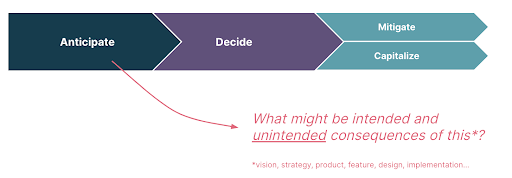As a leader, there are many reasons why you might want to address issues related to sustainability, climate change and social justice. However, whether it’s regulation, personal values, new business opportunities or the need to build customer and employee trust, it can’t be denied that sustainability and responsibility are, today, high on the agenda; they demand attention. This is reflected in research: in the state of Responsible tech report by MIT Technology Review Insight (MITTR), produced in partnership with Thoughtworks, 73% of senior executives and directors agreed that responsible technology considerations will eventually be as important as financial considerations in technology decision-making. In this article we share how you get started with embedding this through responsible tech. The latest IPCC report is a 'final warning' on the climate crisis; as business leaders, we have a critical role in reducing our carbon footprint and promoting sustainable practices. In this article we share how you get started with embedding this through responsible tech.
Responsible tech is a way of working that aligns technology and business behavior with environmental, societal and individual interests. It does this by actively considering values, exploring tech's unintended consequences and negative impacts, and emphasizing the importance of actively mitigating risk and harm while capitalizing on new opportunities. Incorporating responsible tech can empower your organization and teams to make progress in social and environmental sustainability, security and data privacy, privacy and surveillance, accessibility and inclusive design, diversification of the workforce, reducing ethical risk while increasing fairness and safety in artificial intelligence.
It’s important to note that you don’t necessarily need to create full-blown programs that address these issues to start off with (although you can); what matters is initiating a new mindset, providing a manageable starting point for teams where decisions are happening and to prevent the accumulation of ethical debt. As the MITTR research indicates, there isn't a single priority area for leaders when it comes to responsible technology; it really depends on their own organizational context. Thereby it helps to offer guidance and support to the teams where the decisions are made.
So, how do you bring social and environmental sustainability through responsible tech to your organization? Below are some steps you can take immediately to make responsible technology a reality, regardless of your organization.
1. Be the role model
It all starts—and ends—with you. As a leader, it's important to recognize that technology is not neutral and to take responsibility for its impact on all stakeholders, including the environment and society. And if you don't practice what you preach, neither will your team and those around you. The MITTR research found that the main barriers to adopting responsible technology are lack of senior management awareness (52%), organizational resistance to change (46%) and internal competing priorities (46%).
As a leader, showing commitment to responsible tech through your own behavior and actions is key for fostering a wider cultural and organizational change. There’s no single way of doing this; it typically requires multiple approaches, like practicing the principles, investing in education, and linking responsible technology to processes, corporate strategy and incentives.
2. Anticipate and think beyond: check for unintended consequences intentionally and systematically
It’s important to anticipate unintended consequences at every stage, from vision to implementation. One way of doing this is to simply ask: What are the intended consequences of this decision, and what might be the unintended consequences?
Even with good intentions, solutions may have unforeseen consequences. Being sensitive to this fact and taking steps to mitigate them is a key concept in responsible tech, it also fits with most risk and also innovation frameworks that you might already use. Sort the consequences by impact and likelihood and decide whether to mitigate or capitalize on them by thinking about them further (Illustration I).

An example of capitalizing is Apple, who has made privacy a key selling point by emphasizing their commitment to preventing unauthorized access and abuse of personal information. It’s surprising what comes to the surface and what's obvious as (un)responsible to one is new and game-changing for another. ‘Anticipating’ as a fixed step in your processes facilitates such conversations. Then you can bring in adjustments, or new initiatives—early on and not when the milk is already spilled.
Various existing prompts and methods are needed to uncover biases and blind spots to better anticipate potentially negative consequences, they also help you to evaluate the impact constructively. The Responsible tech playbook features excellent tools for this, such as DotEveryone's Consequence Scanning, Artefact's Tarot Cards of Tech and Omidyar Network's Ethical Explorer that offer amazing starting points. Consider the right stakeholders: working with experts and engaging with groups that may be directly or indirectly affected by your solutions can help to uncover biases, rethink or reframe a problem, and uncover opportunities. Finally, team diversity and psychological safety is also important here — having people from a wide range of backgrounds with different perspectives can help challenge assumptions inside teams and minimize the risks of unintended consequences.
3. Work with values and principles
Defined and clear values and principles are a key factor to better navigate the complexity of challenges. In this line, extend your company values with responsible values, so that you empower staff to bring those to their day-to-day work. Organizations that practice responsible tech prioritize a variety of values, including those related to ethical and moral considerations like environmental sustainability, inclusion, and human welfare. These values must be clearly defined, communicated to all stakeholders, and integrated into the design and development process. This ensures that the values are taken into account at every stage of development and that the resulting system aligns with these values (Illustration II). This is a practice which is commonly used in AI development but is useful to be applied beyond that. Aligning your products with your values and principles will help you to make better decisions, improve the customer experience, increase trust and credibility, and reduce possible negative consequences.
It's all well and good to stress the importance of values and principles, but how do you actually arrive at the ones that are most pertinent to your organization?
There are a number of ways:
Develop and implement company-level values and principles. In our experience, it's helpful to agree on and establish good core values and principles at a company level, which include ethical and moral components. This process may take time but is worth the effort.
Encourage adoption at a team level. For individual teams, adopting values and principles can be much faster. You can start to treat the company’s core values and principles as sensible defaults, and take one or two of them as a foundation before breaking them down and to make them more tangible. In other words, articulating what it means for a given product and how it guides action. If those values don’t yet exist, give teams the autonomy to be able to come up with their own guiding values and principles.
Explore values by identifying ethical nightmares. It can be extremely helpful to formulate values and principles by thinking about ethical nightmares your product or company might trigger and then thinking about the opposite. This can complement your company's values. Using tools from the Responsible tech playbook can help you with this; for example, the above mentioned Ethical Explorer method helps us to uncover blind spots and unintended consequences as a first step; as a second step, we use these results to formulate positive principles which give guidance to prevent those unintended consequences.
Think about how you might navigate paradoxes. When we run into paradoxes and deadlocks, Polarity Mapping helps with navigating polarities and doing value adding trade-offs. And when we dig even deeper, value-sensitive design is a whole approach helping with working with values.
Write them down. Last but not least, writing down values and principles with context — such as why the value exists, what actions are taken because of it, different examples of principles and how the principles are connected to these actions — helps make values actionable and communicable.
Expanding responsible tech practices
Once you’ve started with these practices and see first success, you can then become more deliberate: update your guidelines, incorporate them into your processes, see how to monitor better and involve more stakeholders to increase accountability and responsibility. Additionally, you should consider working on underlying organizational structures and culture; think about how you can increase diversity, develop your team’s mindsets and capabilities even further, and adjust KPIs and incentives to strengthen and consolidate your efforts.
In summary: Encourage accountable, anticipative and values-driven decision making
Accountability, anticipation and values-driven decision-making are foundations of responsible tech. With them, organizations can credibly suggest they are serious about addressing climate change, social injustice, and sustainability.
Leadership is essential for success, but a top-down approach on its own is unlikely to be successful: you also need mid-level management that are role models and a bottom-up approach that empowers staff to use value and anticipation frameworks to make decisions in the context of their own projects. And remember, you aren’t on your own — there is a range of methods and tools now available that are designed to be playful, generative and empathetic; they can go a long way in helping shift mindsets.
Once you’ve started on your responsible tech journey, remember to reflect and iterate — expand the scope and refine the reach of your initiative to implement structural changes that leave a positive and lasting legacy on your organization.
Disclaimer: The statements and opinions expressed in this article are those of the author(s) and do not necessarily reflect the positions of Thoughtworks.


















